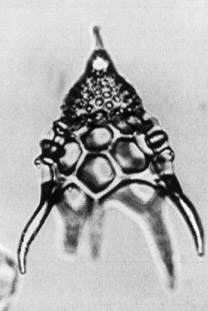 Thyrsocyrtis
(Pentalacorys) tetracantha (Ehrenberg)
Thyrsocyrtis
(Pentalacorys) tetracantha (Ehrenberg) Thyrsocyrtis
(Pentalacorys) tetracantha (Ehrenberg)
Thyrsocyrtis
(Pentalacorys) tetracantha (Ehrenberg)Podocyrtis tetracantha Ehrenberg, 1873, p.254; 1875, pl.13, fig.2; Sanfilippo and Riedel, 1982, p.176, pl.1, figs.11-12, pl.3, fig.10 (with synonymy)
Similar in general form to T. triacantha, but abdomen with very large pores, no differentiated peristome (here resembling pore bars), and 3-6 (most commonly 4) short to long feet, circular in section. Some populations, mainly from the early part of the stratigraphic range, with feet so short as to be practically absent (Sanfilippo and Riedel, 1982).
Based on 25 specimens. Maximum length excluding horn 205-320 µm, of cephalothorax 60-80 µm, of abdomen 50-100 µm. Maximum width 120-155 µm (Sanfilippo and Riedel, 1982).
Differs from T. triacantha and T. bromia in the absence of a differentiated peristome and usually more than three feet, and from T. bromia also in the cephalis not being porous and the horn not tending to have spinules distally (Sanfilippo et al., 1985).
The delicate to robust abdomen has very large pores (1-4 along its length), no differentiated peristome, and feet varying in number from 3-6 (commonly 4). Around the time of transition from T. triacantha to T. tetracantha, the feet in many specimens are reduced to short spikes projecting from the distal margin of some of the pores (Sanfilippo et al., 1985).
T. tetracantha is found in all tropical assemblages of latest middle to late Eocene age. Its morphotypic first appearance lies within the Podocyrtis goetheana Zone. Its morphotypic last appearance defines the base of the Cryptocarpium ornatum Zone.
T. tetracantha evolved from T. triacantha and left no known descendants.